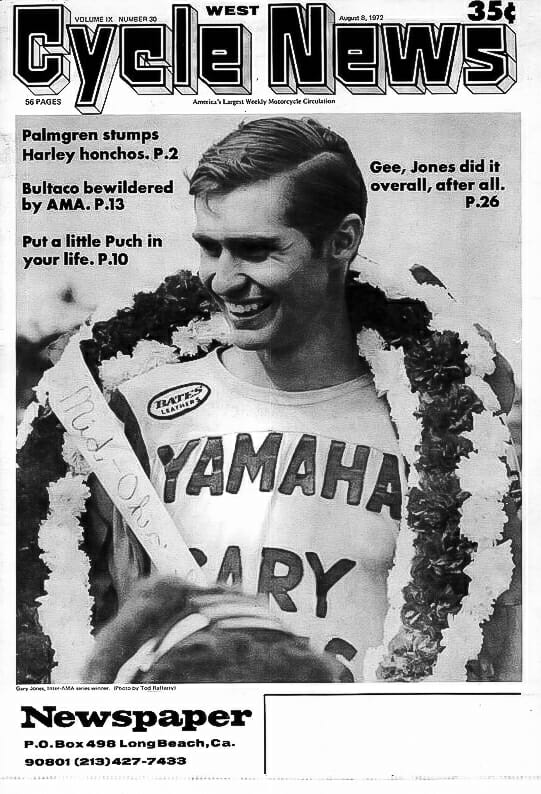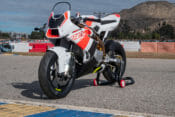Cycle News Archives
COLUMN
This Cycle News Archives Column is reprinted from issue #16, April 28, 2004. CN has hundreds of past Archives columns in our files, too many destined to be archives themselves. So, to prevent that from happening, in the future, we will be revisiting past Archives articles while still planning to keep fresh ones coming down the road -Editor.
He Was Really Good
By Scott Rousseau
Just how good was former AMA 250cc National Motocross Champion Gary Jones? So good that the three-time champ actually won the title four times—depending on whom you ask. So good that he won the three titles not in doubt aboard three different motorcycle brands. So good that he actually rode for Maico while riding for Honda.
That’s how good.

Jones’ saga is that of a brief racing career that was lived to the fullest and a life centered around a love for motorcycles. Although his road has skewed in many directions, the start of the path is typical enough. At the start of the motocross movement, the Jones boys, Gary and Dewayne, under the tutelage of their father, “Pappy” Don Jones, were simply riding motorcycles elsewhere.
“I was about 17, and I was racing short track and speedway in ’68,” Jones says. “My dad was a Yamaha dealer, and I remember they came out with this new DT-1. It was really fast. It was a two-stroke, and it was light. So, my dad decided to make it so that I could race motocross just so that I could ride two classes. I would ride my 441 BSA in one class and the Yamaha in the other.”
As he instantly adapted to the rough world of motocross racing, Jones began to spend more time racing the DT-1 while “Pappy” continued to develop the machine.
“Yamaha had some deal where they put up a bunch of money—I think it was $15,000—here in the States for anyone who could beat the Europeans, so my dad just told us, ‘We’re going to go do that!’” Jones says. “But the Yamahas needed a lot of help. They’d just throw you right off. We needed to find out why, and we didn’t figure it out until we started looking at things. We cut ’em and changed head angles and tried different swingarms, all kinds of things.”
Pretty soon there was more than just shade-tree mechanical know-how going into the Jones bikes. Even the United States government was helping the cause—though Uncle Sam didn’t know it at the time.
“We had friends at the Jet Propulsion Laboratory and Missile Welding who were helping us with trick titanium parts that we’d have them make special for us,” Jones says.
The family’s R&D project even got the attention of the Yamaha factory, who sent any parts the Jones clan needed, signed Gary to a factory deal by 1971 and, after carting a Jones-modified DT back to Japan, returned with the first true factory YZ for him to ride in the new AMA Motocross series that year.
“We had factory bikes, but they had nothing to sell yet,” Jones says. “The first production YZ that was a replica of what we were riding wasn’t until 1974. Certain dealers could get a YZ before that time, but I don’t know how that worked.”
Armed with the YZ, Jones pretty much owned the 1971 season and repeated for Yamaha in 1972, except the AMA only credits him with the 1972 title. Jones argues that 1971 should count as National title as well. So, who’s right? Jones may have the better memory. After all, the AMA doesn’t even credit his 1974 title to the right brand. Jones won that title aboard a Can-Am in a year that the former Bombardier-owned motorcycle marque swept the top-three positions in the 250cc class.
“I actually won it twice for Yamaha, but that first year [1971] they didn’t call it a National series. Then they did, and then they didn’t, so I don’t know what to say on that one. I say four, and everybody else says four, but the AMA says three, so I don’t know what to tell you. That’s the AMA.”
But that’s getting ahead in the story, because after two great years for Yamaha in 1971 and 1972, Jones switched to Honda.
“Honda offered us more money,” he says. “They gave me about $50,000—more money than I even dreamed about—plus expenses, when the average wage was about $15,000 per year. They flew me to the races and had mechanics taking care of my bikes. We didn’t have to do any of that anymore. It gave me so much confidence that I just felt like nobody could beat me.”
Nobody did. Jones repeated as AMA 250cc Champion for 1973. Even so, things quickly went sour at Honda after the manufacturer balked on getting Jones Open-class bikes for the Trans-Am Series at the end of the year.
“They screwed up on the contract,” Jones says. “They gave me one Open bike to run the U.S. GP on, but they took that back. I wanted to race the Open class in the Trans-Am, but they said, ‘No, no. Just ride the Support class.’ I was National Champion. I wasn’t going to ‘just ride the Support class.’ My contract read like Nicky Hayden’s, where if Honda didn’t make and sell a bike for me to race, I could ride something else. So, I went and bought my own Maico and rode it for one race with Honda clothes to keep up my end of the deal. Honda was so hot about it that they bought out the rest of my contract so that they could get rid of me. I put together a deal with Maico for the rest of the year, which was okay with me.”
Then Can-Am doubled up the Honda money for 1974, and the Canadian firm bought itself a champion. Jones, once again, held up his end of the deal, winning the title as mentioned above.
“It was a two-year deal,” Jones says. “At first, I had so many problems with stuff breaking, and we had problems with some of Can-Am’s upper management. I won’t mention any names—Jeff Smith—but they wouldn’t let us do the things that we needed to do. They would say, ‘Oh no, the bicycle works fine.’ Finally, we just changed the stuff on our own and didn’t tell them. That got me through to the end. We had hired Marty Tripes, who was starving on a Husky, and Jimmy Ellis for that year, too. We went one-two-three. I don’t know of any manufacturer who has done that since.”
As Daytona ’75 came into view, it would seem that there was just no stopping Jones. Armed with a much-improved factory Can-Am, he was optimistic that he could retain his 250cc title once more. But in a split second, it all came to a crashing end.
“I ran into Peter Lamppu—God rest his soul,” Jones remembers. “He was riding a CZ, and he crashed in front of me in practice, and his bike flipped up and hit me, and my foot went right in his wheel. It broke my leg so badly that I was out for a year and a half after that. That was it. I was done. Modern medicine wasn’t what it is today. I was only 22.”
There’s so much more to tell about Gary Jones, from the devastating loss of a personal fortune after his own motorcycle company imploded due to forces beyond his control, to his rebounding as a key player in the organizations of Noleen Racing and White Brothers. Those are stories for another day.
Suffice it to say that from 1971-1975, Gary Jones was as good as they come. CN
Jones was inducted into the AMA Motorcycle Hall of Fame in 2000. In 2010, the Gary Jones Cup was created to honor the top 250cc team in the AMA Pro Motocross Championship. Jones is still an active motorcycle racer, as well as a side-by-side racer. When he’s not competing, he helps organize side-by-side racing at Glen Helen Raceway. -Editor.
Click here to read the Archives Column in the Cycle News Digital Edition Magazine.
Subscribe to nearly 50 years of Cycle News Archive issues
Click here for all the latest Supercross and Motocross news on Cycle News.
